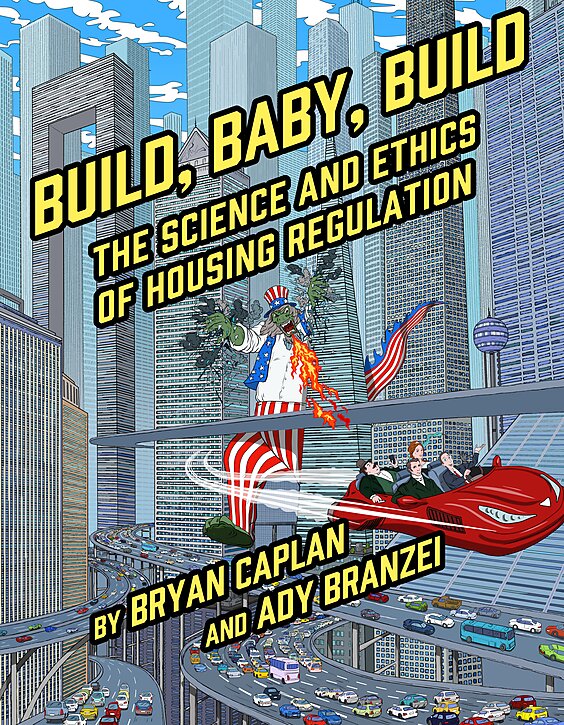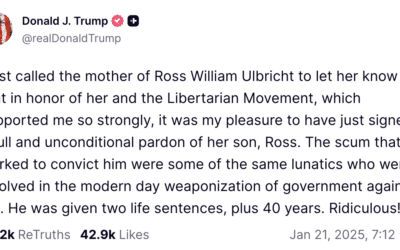Economist Bryan Caplan has done it again. His latest graphic nonfiction book is Build, Baby, Build: The Science and Ethics of Housing Regulation, illustrated by Ady Branzei and published by the Cato Institute. (His first was Open Borders: The Science and Ethics of Immigration.)
Caplan’s target is a worthy one: zoning and other (anti-)housing regulations, which damage many people in various ways, some that will surprise you. While he could have written a conventional book, it almost certainly would have been dreadfully dull and accessible to only a few academics and policy wonks. That is no reflection on Caplan, an excellent writer. It’s in the nature of the subject. I probably don’t need to persuade many people of that statement.
So what’s the problem? All state and local governments suppress the supply of houses and apartments throughout the country—and the problem has gotten worse for most of the country. Let’s be clear: many more dwellings of all types, including high-rise apartments, would exist and be much cheaper were it not for government prohibitions, requirements, and other cost-boosting impediments.
The housing shortage, then, is not caused by greedy construction executives trying to squeeze buyers and renters into poverty or by immigrants. It’s caused by do-gooder politicians and bureaucrats along with members of the public who just don’t get it. Construction companies would love to build, sell, and, rent more units, which would drive down the price. Governments won’t let them. That’s criminal.
Basic economics teaches that market prices result from supply and demand. If government restricts the supply of something people want, whether or not by design, prices will rise. For housing, this is most aggravated in the most desirable parts of the country, where the demand for homes is high because of the many amenities, including high-paying jobs. In a free market, high prices beckon new competitors and increase supply, thereby lowering prices. It’s a beautiful process when allowed to work.
Few things are more certain than the relationship between supply and demand on the one hand and price on the other. Yet many people don’t get it.
According to Caplan, “Americans spend about 20% of their budget on housing.” If builders were free to build, the average price of housing would fall to half of what it is today, he writes. This would raise living standards appreciably for nearly everyone. The effect on lower-income people would be stunning. Many aspects of life would dramatically improve: “the labor market, poverty, social mobility, family formation, long commutes, the environment, and the American dream.” (See the book for details.)
The benefits would be so immense that Caplan calls housing deregulation a “panacea”: so many problems would be alleviated. This includes not just obvious ones, such as the barrier to job mobility. Under current conditions the higher wage in the big coastal cities is not enough to offset the exorbitant price of houses and apartments. Why would a person relocate if he wouldn’t be able to afford a home near his workplace? But it’s not only that frustrated person who loses. Locations with higher pay are that way because worker productivity is higher. If regulation locks people out of high-productivity locations, everyone loses because fewer goods will be produced.
Housing deregulation would also relieve problems less obviously connected to housing. For example, with freedom the number of construction jobs would explode all over the country. That would primarily benefit young men without college diplomas, who now have a tough time getting good-paying jobs. Such unemployment or underemployment creates all kinds of problems. Caplan supplies more examples to justify his use of the descriptor panacea.
So who’s against housing deregulation? For one, bureaucrats corrupted by the social-engineering mentality. They think they know better than market participants how cities and suburbs ought to look. Many regular people also oppose new housing developments. We usually think that the NIMBY crowd is trying to protect the value of their houses. However, Caplan doesn’t believe that narrow economic interest is the best answer. For one thing, renters tend to oppose development too. As he puts it, “Political scientists have long known that objective self-interest poorly predicts voting. Self-interest poorly predicts partisanship. Self-interest poorly predicts issue views.”
Then why do so many people oppose housing deregulation? Caplan has three explanations: economic ignorance, innumeracy, and status-quo bias. This adds up to an attitude that minimizes or overlooks the benefits of more housing and exaggerates the downside. Caplan presents reasons why housing-deregulation foes ought to change their mind: namely, they have much to gain that they never thought. For instance, cheaper housing would mean that many people’s grown children could move out of their basements, start families, and afford housing close by. Deregulation would also mean that people could enjoy windfalls from the new freedom to subdivide single-family-home lots for multifamily dwellings. How many people would rank those things over preserving the status quo?
This does not mean new building would have no downside, such as parking problems and road congestion. Caplan responds that these problems can and should be addressed in ways other than suppressing the supply of housing. What other ways? By letting the price system work. Just as there is no such thing as a free lunch, there’s no such thing as truly free roads and parking. Congestion and aggravation are costs. Peak market pricing is a better answer than suppressing housing supply. Caplan discusses targeted “keyhole policies” that might be politically necessary to win adherents to the cause of house-building freedom.
In sum, he shows why people who embrace different approaches to social questions—utilitarians, egalitarians, cost-benefit trackers, and libertarians—can unite over housing deregulation.
Caplan is onto something. He demonstrates—graphically—that freedom really works.
















